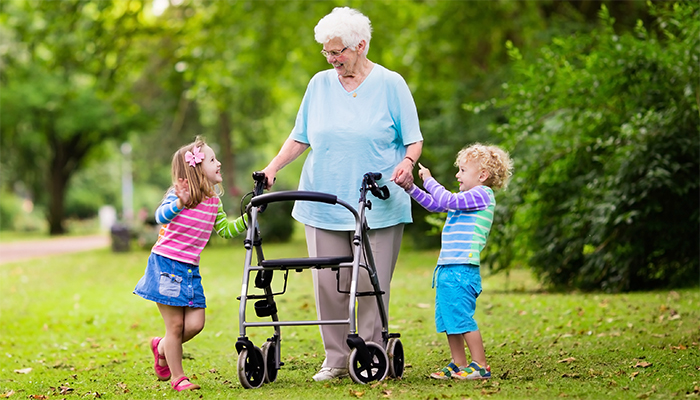Family Caregiver Connection
Helpful tips for family caregivers
August/September 2024
There is no doubt that a rollator can make a big difference in your relative’s quality of life. It allows for mobility and continued engagement, which are good for the body and the mind. Hope is also important for physical and mental health. In our middle article, we help you identify realistic caregiving hopes as distinct from blind optimism. Last, we offer strategies so the person you care for can remain independent and in charge of their daily finances.
How to choose a rollator
If the person you care for has generally good balance and needs just minimal support for getting around, a rollator (walker with wheels and brakes) might be preferable to a standard walker. Rollators enable a more normal, fluid stride. The features to consider start with size, weight, and foldability. If the rollator will be used outside the house, it must fit in the trunk of the car or behind the passenger seat. Is it light enough for your relative to lift themselves? Does it fold easily and to a workable size?
Another issue is the number of wheels and wheel size. The three-wheeled models are narrower and more maneuverable. This makes them ideal for indoors. Outdoors, wheel size is important. Small wheels don’t handle uneven paving very well (e.g., a sidewalk buckled by tree roots). A rollator with four large, fat wheels is less likely to abruptly halt or tip over.
Brakes are another concern. Will your loved one be walking up or down hills (even across the slope of driveways)? Most braking systems involve a hand grip that pushes a wedge into the tire, producing a quick stop. For downhill slopes, you want a larger brake that compresses a large part of the wheel and allows for a more gradual slow down.
Accessories are an important part of rollators. Does your relative need a seat, for instance? If so, is the seat for short rests, or would your loved one sit in the walker for a few hours at a time? If the latter, look for a seat with good cushioning. Other accessories often revolve around using the walker to carry items. Would a simple bag or a basket do? Is a cup holder needed? Or a tray for transporting a plate or bowl from the microwave to the dining table?
Some people get two rollators:
- For home. A three-wheeler with 6″ tires, wedge brakes, a hard seat (or no seat), and desired accessories. It can be heavier (20–24 pounds). Size and flexibility don’t matter.
- For outdoor uses. A three- or four-wheeler. Lightweight for lifting (13–15 pounds) and collapsible to fit easily into the car. Most important, you want large tires (8–10″) for safe walking on uneven surfaces. Wide tires and compression brakes reduce the chance of tipping or having the rollator go too quickly down a slope or driveway. A cushy seat may be the most essential accessory.
Hope: It's not what you think
We all need hope. It motivates us to get up in the morning and get going on the day. It makes our burdens less tiring. It’s even been documented to reduce anxiety and depression while improving health and quality of life.
Hope is not a blind conviction that everything will be okay.
Hope involves a process (often internal, unconscious). Hope requires having a goal, having options for achieving the goal (pathways), and believing in one’s ability to take meaningful action.
Hope is generally possible, but it may not be everything you want.
Hope for a cure in a cancer situation, for example, is a natural desire. But it’s not a hope you can make come true. Instead, convert it to something you can affect, such as having hope to make the treatment as easy as possible. Does your loved one have a hard time with chemo? Here you do have many options:
- Learn about the side effects.
- Be ready with remedies for nausea.
- Pick the best time of day for treatment.
- Find the easiest transportation there and back.
- Simplify daily activities and be patient if your relative struggles with the fog of “chemo brain.”
If you find yourself losing hope, examine what you are hoping for. Is it something you can influence? If not, revise your hope to something more within your ability to change. And if everything seems outside your reach—which happens often in caregiving—then make sure there is some other part of your life where you can achieve a desired goal. Make a plan and follow it so you can feel that at least one area of your life is under your control.
Return to topMoney tips for low vision
The ability to handle one’s own financial affairs is critical to adult independence. Low vision challenges this freedom.
Fortunately, most banks are prepared to assist clients, whether banking online or in person. Online, your loved one can adjust the bank’s website for large print. Plus, many banks provide instructions on how to use a screen reader. Banks can also issue large-print checks and monthly statements in large print, braille, or audio versions. Some banks now have audio-accessible ATMs (and braille keyboards). By inserting a headphone jack, the ATM switches to audio mode. Consider a check template (like a stencil) for your relative, indicating where to write the date, payee, dollar amount, and signature.
To support your relative in storing and spending cash, look for a “low-vision wallet” with multiple compartments that facilitate storage by denomination. Folding bills will help your relative quickly identify what’s in their wallet. Keep ones flat. Fold fives in half to make something of a square. Fold tens in half lengthwise to make a skinny rectangle. Fold twenties twice to make a rectangle one-fourth the size of a normal bill.
To identify American bills, the Bureau of Engraving and Printing—the division in charge of printing money—created a free app, “EyeNote®.” It scans bills and speaks the dollar value. Or when set in privacy mode, it pulses the value with vibrations or beeps. (One dollar is one pulse, two dollars is two pulses, five is three, ten is four, twenty is five ….)
When receiving money at the bank, have your loved one ask for bills all in one denomination, such as all tens. Or ask the teller to count them out in denominations (all the twenties together, all the tens together, all the fives …). This helps for storing and then folding appropriately when at home.
Return to top



